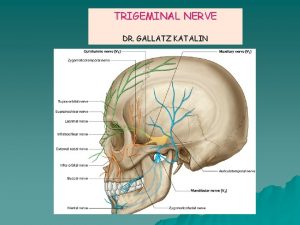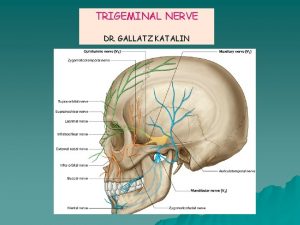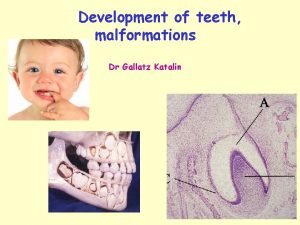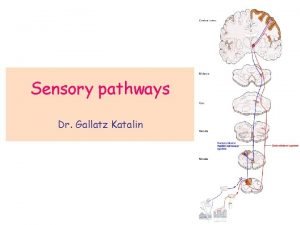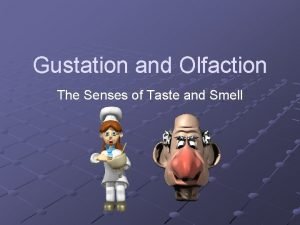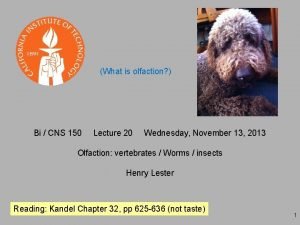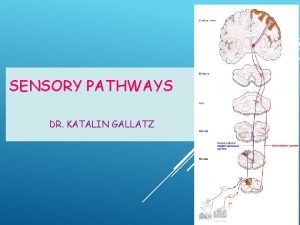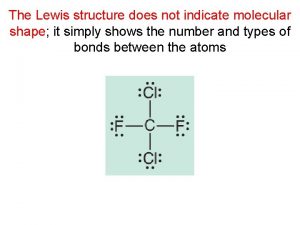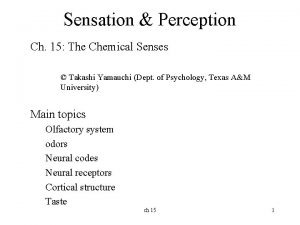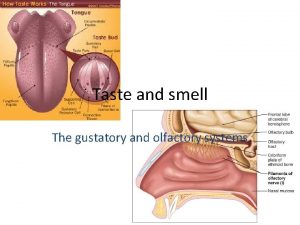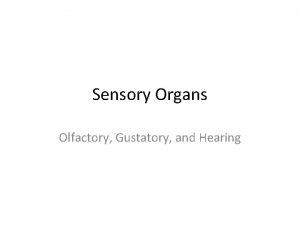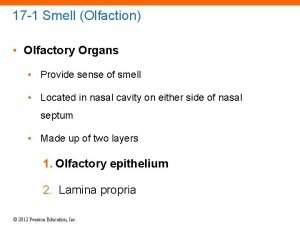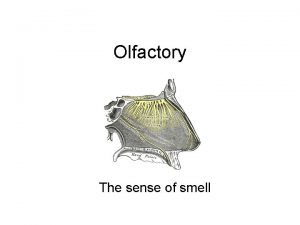Olfactory and gustatory system Dr Katalin Gallatz OLFACTION




























- Slides: 28

Olfactory and gustatory system Dr. Katalin Gallatz

OLFACTION • Olfctory region of the nasal cavity contain olfactory epithelium with olfactory receptors, supporting cells, basal cells – Olfactory receptors are primary sensory epithelial cells (modified neurons) • Surfaces are coated with mucous secretions from olfactory glands • Olfactory reception involved detecting dissolved chemicals (odorant materials) as they interact with odorant binding proteins

OLFACTION • Olfactory discrimination – Can distinguish thousands of chemical stimuli • CNS interprets smells by pattern of receptor activity – Olfactory receptor population shows considerable turnover – Number of receptors declines with age

Parts of the olfactory system Olfactory epithelium: primery sensory epithelial cells central branches - fila olfactoria Olfactory bulb: mitral and tufted cells axons olfactory tract Olfactory tract: stria olfactoria medialis, intermedius et lateralis Olfactory areas: praepiriform cortex entorhinal cortex, AMYGDALA

o t o

OLFACTORY REGION Aromas reach the olfactory epithelium

ORTHONASAL and RETRONASAL OLFACTION

OLFACTORY EPITHELIUM • Specialized , , neurons” present in the olfactory epithelium in the nose. • They project cilia into a mucus layer. The odorant receptors of the cilia are able to bind to odorant molecules. • Each olfactory receptor is specialized for 1 odorant molecule ORC = olfactory receptor cells

Olfactory transduction - G-Protein Receptor

Olfactory cells: - primary sensory epithelium - bipolar cells: dendritic process to the direction of the surface, olfactory processes to the direction of the lamina propria fila olfactoria olfactory bulb

Olfactory bulb 1. Olfactory fila synapse with the dendrites of the mitral and tufted cells olfactory glomerulus 2. Axons of the mitral and tufted cells form the olfactory tract 3. Inhibitory granule cells get centrifugal fibers from the anterior olfactory nucleus locus coeruleus and dorsal raphe nucleus, and inhibit the mitral and tufted cells

OLFACTORY BULB LAMINA CRIBROSA OLFACTORy EPITHELIUM

Olfactory tract: axons of the mitral and tufted cells terminate in the anterior olfactory nucleus and in the olfactory cortical areas Fibers from the anterior olfactory nucleus synapse with the granule cells of the contalateral olfactory bulb .

Olfactory cortical areas: amygdala, Prepiriform cortex – uncus Entorhinal cortex – parahyppocampal gyrus Orbitofrontal cortex

OLFACTORY PATHWAYS

OLFACTORY PATWAYS ORBITOFRONTAL CORTEX

OLFACTORY PATHWAYS Secunder olfactory cortex

Gustatory system

Taste bud secondary sensory epithelial cells supporting cells basal cells


Gustatory discrimination • Primary taste sensations – Sweet, sour, salty, bitter – Receptors also exist for umami and water • Taste sensitivity shows significant individual differences • The number of taste buds declines with age

Umami, or savory taste, is one of the five basic tastes (together with sweetness, sourness, bitterness, and saltiness). It has been described as brothy or meaty. People taste umami through taste receptors that typically respond to glutamate. Glutamate is widely present in meat broths and fermented products, and commonly added to some foods in the form of monosodium glutamate (MSG). [ Since umami has its own receptors unami now is considered to be a distinct taste.

TASTE RECEPTORS

GUSTATORY PATHWAY TASTE BUDS VII. , IX. , X. I. neuron Geniculate ggl VII. inf. ggl IX. n inf. X. n. II. neuron nucl. of solitary tract III. neuron VPM parvocellular part Postcentral gyrus - insular cortex VII. IX.

Gustatory system 1. Taste buds 2. VII. , IX. , X. 3. geniculate ggl. VII. n. inf. ggl. of n. IX. inf. ggl of n. X. 4. nucl. of solitary tract 5. VPM parvocellular part 6. postcentral gyrus


Connection between the olfactory and gustatory system nucleus of solitary tract parabrachial nucleus hypothalamus amygdala

Thank you for your attention!
 Ggl trigeminale
Ggl trigeminale Dr gallatz katalin
Dr gallatz katalin Caliculi gustatorii
Caliculi gustatorii Somita embriologia
Somita embriologia Gallatz
Gallatz Bélkacs
Bélkacs Koczka katalin
Koczka katalin Spinothalamic tract
Spinothalamic tract Histology
Histology Basal ganglia anatomy
Basal ganglia anatomy Ggl oticum
Ggl oticum Gustatory system
Gustatory system Gustation and olfaction
Gustation and olfaction Olfaction
Olfaction Chemoreceptor example
Chemoreceptor example Which lobe is broca's area in
Which lobe is broca's area in Examples of aural imagery
Examples of aural imagery Gustation refers to
Gustation refers to Gustatory epithelial cells
Gustatory epithelial cells Gustatory cells
Gustatory cells Gustatory cells
Gustatory cells Sexual hallucinations
Sexual hallucinations Fascicle of goll and cuneate fascicle
Fascicle of goll and cuneate fascicle Mandibula parts
Mandibula parts Olfactory groove keros classification
Olfactory groove keros classification Olfactory
Olfactory Olfactory receptor cells
Olfactory receptor cells Olfactory mucosa
Olfactory mucosa Site:slidetodoc.com
Site:slidetodoc.com
